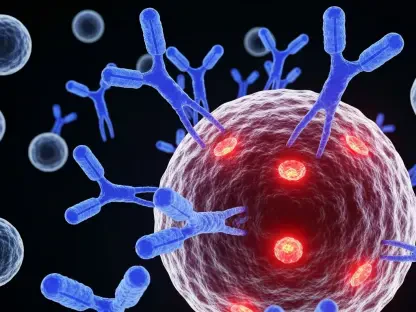The recent study on emerging bat viruses, particularly those related to the Middle East respiratory syndrome coronavirus (MERS-CoV), has raised significant interest and concern in the scientific community. We’re speaking with Ivan Kairatov, a biopharma expert renowned for his innovation in tech and research development, to delve into the intricate findings and potential implications of this groundbreaking work.
What are merbecoviruses, and how are they related to the Middle East respiratory syndrome coronavirus (MERS-CoV)?
Merbecoviruses are a subgenus of coronaviruses that include the notorious MERS-CoV, which first emerged in 2012. MERS-CoV is known for its high mortality rate and its zoonotic transmission from camels to humans. While many merbecoviruses do not directly threaten humans, they share a similar genetic lineage, posing potential risks if they mutate.
Can you elaborate on the specific subgroup HKU5 and its concerning traits?
HKU5 is a subgroup within the merbecoviruses that has sparked concern due to its peculiar ability to bind to ACE2 receptors, albeit not as effectively in humans. This trait indicates a potential for cross-species transmission, akin to the dynamics observed with other zoonotic viruses like SARS-CoV-2. The HKU5 viruses have already been found infecting multiple regions across the globe, suggesting a wider geographical adaptability.
What were the main objectives of the study published in Nature Communications?
The study aimed to bridge the gap in understanding how merbecoviruses, specifically HKU5, interact with host cells. By focusing on these interactions, the researchers hoped to identify the viruses’ potential risk in crossing over to humans and deduce the mutations necessary for such an event.
Why has there been limited research on merbecoviruses before this study?
The research on merbecoviruses has been sparse due to their previous classification as low risk to humans, apart from MERS-CoV. Lack of immediate public health threats and limited funding directed research efforts elsewhere until the urgency for broader coronavirus research became apparent, especially after the COVID-19 pandemic.
What role do spike proteins play in the infection process of merbecoviruses?
Spike proteins are crucial as they enable the virus to attach and penetrate host cells. They bind to specific cellular receptors, allowing the viral genome to enter and hijack the host’s biological mechanisms. In merbecoviruses, and coronaviruses at large, this process determines which species a virus can infect.
How was the research team able to test the ability of merbecoviruses to infect cells in the lab?
The team utilized virus-like particles containing only the spike protein portion critical for receptor binding. This method allowed them to evaluate the infection capabilities of merbecoviruses without handling infectious viruses, thereby determining their interaction with various host cells.
How does the spike protein of HKU5 compare to SARS-CoV-2 in terms of binding to ACE2 receptors?
The HKU5 spike protein does bind to ACE2 receptors, much like SARS-CoV-2. However, its affinity is currently limited to ACE2 receptors found specifically in bats. This limitation is due to variations in the spike protein structure that, if mutated, might enable it to effectively bind to human receptors.
What mutations in the HKU5 spike protein might enable the virus to bind to human ACE2 receptors?
The study pinpointed specific mutations in the spike protein that could potentially increase the binding affinity to human ACE2 receptors. These mutations would allow the virus to adapt the lock-and-key fit required for penetrating human cells, which is critical for cross-species transmission.
What are the implications of HKU5 viruses having the potential to cross species barriers?
If HKU5 viruses overcome the species barrier, they could lead to outbreaks in new host populations, including humans. This adaptive leap carries the risk of new epidemics or pandemics, underscoring the importance of preparedness and surveillance for such events.
Have there been any documented cases of HKU5 viruses infecting species other than bats, such as minks?
Yes, there has been at least one documented case where an HKU5 virus has spilled over into minks. This instance exemplifies the virus’s ability to cross species barriers, serving as a precursor for concern regarding their potential impact on different mammalian species, including humans.
What is the significance of the research team’s use of artificial intelligence, specifically AlphaFold 3, in the study?
AlphaFold 3 allowed the team to rapidly model the spike protein’s structure and interactions with ACE2 receptors, providing insights into potential mutations and binding affinities. This AI-assisted approach significantly expedited the research process, offering predictions that matched traditional methods but in a fraction of the time.
How did the predictions generated by AlphaFold compare to those obtained through traditional methods?
The predictions from AlphaFold 3 were strikingly accurate and consistent with results from conventional experimental approaches. This parallel underscored the tool’s efficacy in providing valuable structural insights quickly, which is invaluable in high-priority research situations.
In what ways could the findings of this study aid in the development of new vaccines and treatments?
Understanding the mechanisms of HKU5 infection and potential mutations can guide the design of vaccines that preemptively target these viral factors. Additionally, identifying commonalities between HKU5 and other coronaviruses could aid in developing broad-spectrum antiviral treatments.
Can you discuss the potential impact of HKU5 viruses on public health if they were to spill over into human populations?
The spillover of HKU5 viruses into humans could herald severe public health challenges, requiring rapid responses to contain transmission, insightful drug and vaccine development, and extensive international collaboration to mitigate widespread impacts.
What precautions or monitoring should be implemented to address the potential threat of HKU5 viruses?
Proactive surveillance in wildlife populations, early detection systems, and genomic studies are crucial measures. Expanding research on viral behaviors across different hosts can help in anticipating transitions that could result in human infections.
How did the funding from the National Institutes of Health contribute to the research?
The NIH funding played a pivotal role by providing the financial resources necessary for extensive laboratory studies and technological innovations such as using AlphaFold. This support underpins the exploratory nature of this virus research.
How might this research pave the way for future studies on emerging bat viruses?
This research sets a framework for understanding and predicting bat virus behavior before they emerge as threats. It stresses the importance of studying viral jumps between species to preemptively manage potential outbreaks, which can direct future global virology research agendas.









